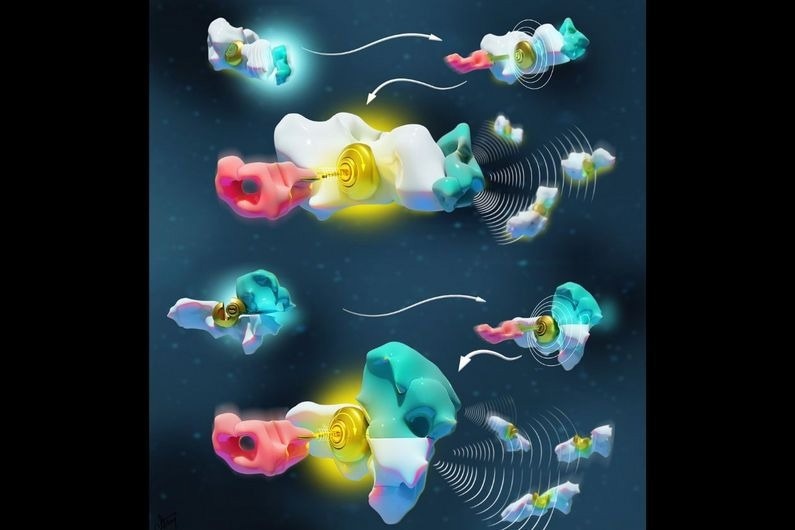Due to groundbreaking work by Canadian scientists at Université de Montréal, two molecular languages at the origin of life have been efficiently recreated and mathematically evaluated.
 The illustration depicts two chemical languages at the basis of molecular communication. The same white molecule, represented as a lock, is activated either via allostery (top) or multivalency (bottom). The allosteric activator (cyan) induces a conformational change of the lock while the multivalent activator provides the missing part of the lock, both enabling the activation by the key (pink). Image Credit: Mooney Medical Media / Caitlin Mooney
The illustration depicts two chemical languages at the basis of molecular communication. The same white molecule, represented as a lock, is activated either via allostery (top) or multivalency (bottom). The allosteric activator (cyan) induces a conformational change of the lock while the multivalent activator provides the missing part of the lock, both enabling the activation by the key (pink). Image Credit: Mooney Medical Media / Caitlin Mooney
The discovery paves new paths to developing nanotechnologies with applications that include drug delivery, biosensing, and molecular imaging. The study was published in the Journal of American Chemical Society.
Living organisms are composed up of billions of nanostructures and nanomachines that interact to make possible for higher-order entities to execute several needed things, like thinking, moving, reproducing, and surviving.
The key to life’s emergence relies on the development of molecular languages—also called signalling mechanisms—which ensure that all molecules in living organisms are working together to achieve specific tasks.
Alexis Vallée-Bélisle, Study Principal Investigator and Bioengineering Professor, Universite De Montreal
For instance, on assessing and binding a mating pheromone in yeasts, billions of molecules will interact and synchronize their activities to start union, stated Vallée-Bélisle, who holds a Canada Research Chair in Bioengineering and Bionanotechnology.
As we enter the era of nanotechnology, many scientists believe that the key to designing and programming more complex and useful artificial nanosystems relies on our ability to understand and better employ molecular languages developed by living organisms.
Vallée-Bélisle, Canada Research Chair, Bioengineering and Bionanotechnology, Universite De Montreal
Two Types of Languages
Allostery is one well-known molecular language. “Lock-and-key” is the mechanism of this language, where a molecule binds and alters the structure of another molecule, guiding it to inhibit or trigger an activity.
Multivalency is the second lesser-known molecular language, which is also called the chelate effect. It functions as a mystery: as one molecule binds to the other one, it enables (or not) the binding of a third molecule by just increasing its binding interface.
Despite observing these two languages in all molecular systems of every living thing, it is only in recent times that researchers have begun comprehending their principles and rules—and hence employ these languages to develop and program new artificial nanotechnologies.
Given the complexity of natural nanosystems, before now nobody was able to compare the basic rules, advantage or limitations of these two languages on the same system.
Vallée-Bélisle, Canada Research Chair, Bioengineering and Bionanotechnology, Universite De Montreal
To do so, his doctoral student Dominic Lauzon, the study’s first author, had the notion of producing a DNA-based molecular system that would also function with the use of both languages. “DNA is like Lego bricks for nanoengineers,” stated Lauzon. “It's a remarkable molecule that offers simple, programmable and easy-to-use chemistry.”
Simple Mathematical Equations to Detect Antibodies
The scientists discovered that easy mathematical equations could well explain both languages, which disclosed the design rules and parameters to engineer the interaction between molecules inside a nanosystem.
For instance, although the multivalent language facilitated control of the cooperativity and sensitivity of the activation or deactivation of the molecules, the equivalent allosteric translation only facilitated control of the response’s sensitivity.
Using this novel understanding, the scientists employed the language of multivalency to develop and program a programmable antibody sensor that enables the detection of antibodies over various concentration ranges.
“As shown with the recent pandemic, our ability to precisely monitor the concentration of antibodies in the general population is a powerful tool to determine the people's individual and collective immunity,” added Vallée-Bélisle.
Besides enlarging the synthetic toolbox to produce the next generation of nanotechnology, the discovery of researchers also focuses on why certain natural nanosystems might have chosen one language over the other one to communicate chemical information.
The financial support was offered by the National Sciences and Engineering Research Council of Canada, the Canada Research Chairs program, and Les Fonds de recherche du Québec – Nature et technologies.
Journal Reference:
Lauzon, D., and Vallée-Bélisle, A. (2023) Programing Chemical Communication: Allostery vs Multivalent Mechanism. American Chemical Society. doi.org/10.1021/jacs.3c04045
Source: http://www.umontreal.ca/